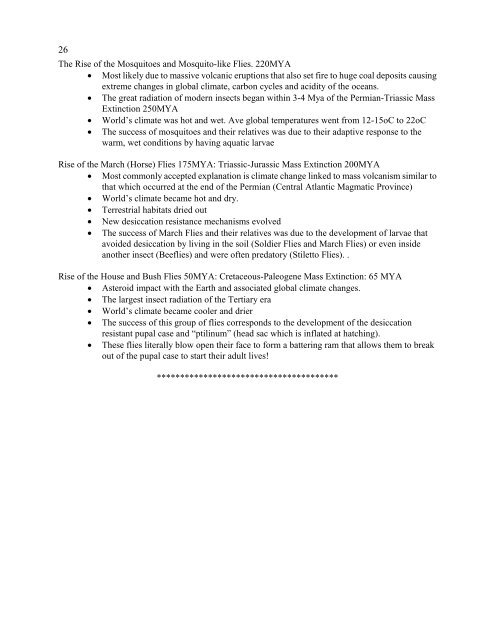Fly Times Issue 48, April 2012 - North American Dipterists Society
Fly Times Issue 48, April 2012 - North American Dipterists Society
Fly Times Issue 48, April 2012 - North American Dipterists Society
You also want an ePaper? Increase the reach of your titles
YUMPU automatically turns print PDFs into web optimized ePapers that Google loves.
26<br />
The Rise of the Mosquitoes and Mosquito-like Flies. 220MYA<br />
• Most likely due to massive volcanic eruptions that also set fire to huge coal deposits causing<br />
extreme changes in global climate, carbon cycles and acidity of the oceans.<br />
• The great radiation of modern insects began within 3-4 Mya of the Permian-Triassic Mass<br />
Extinction 250MYA<br />
• World’s climate was hot and wet. Ave global temperatures went from 12-15oC to 22oC<br />
• The success of mosquitoes and their relatives was due to their adaptive response to the<br />
warm, wet conditions by having aquatic larvae<br />
Rise of the March (Horse) Flies 175MYA: Triassic-Jurassic Mass Extinction 200MYA<br />
• Most commonly accepted explanation is climate change linked to mass volcanism similar to<br />
that which occurred at the end of the Permian (Central Atlantic Magmatic Province)<br />
• World’s climate became hot and dry.<br />
• Terrestrial habitats dried out<br />
• New desiccation resistance mechanisms evolved<br />
• The success of March Flies and their relatives was due to the development of larvae that<br />
avoided desiccation by living in the soil (Soldier Flies and March Flies) or even inside<br />
another insect (Beeflies) and were often predatory (Stiletto Flies). .<br />
Rise of the House and Bush Flies 50MYA: Cretaceous-Paleogene Mass Extinction: 65 MYA<br />
• Asteroid impact with the Earth and associated global climate changes.<br />
• The largest insect radiation of the Tertiary era<br />
• World’s climate became cooler and drier<br />
• The success of this group of flies corresponds to the development of the desiccation<br />
resistant pupal case and “ptilinum” (head sac which is inflated at hatching).<br />
• These flies literally blow open their face to form a battering ram that allows them to break<br />
out of the pupal case to start their adult lives!<br />
***************************************
















